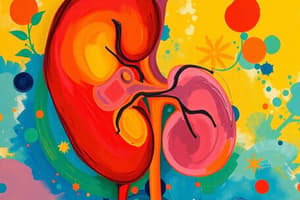Podcast
Questions and Answers
A patient is admitted with fluid volume deficit. Which assessment finding would indicate that the patient is experiencing fluid overload?
A patient is admitted with fluid volume deficit. Which assessment finding would indicate that the patient is experiencing fluid overload?
- Flattened neck veins
- Dry mucous membranes
- Bounding pulses (correct)
- Muscle weakness
Which of the following is a sign of hypernatremia?
Which of the following is a sign of hypernatremia?
- Muscle weakness
- Trousseau's sign
- Seizures (correct)
- Hyperactive reflexes
A patient with hypokalemia is at risk for which of the following?
A patient with hypokalemia is at risk for which of the following?
- Hypoglycemia
- Hypertension
- Cardiac arrhythmias (correct)
- Pulmonary edema
Which of the following is an isotonic IV solution used for replacing fluids and electrolytes?
Which of the following is an isotonic IV solution used for replacing fluids and electrolytes?
What is the main function of aldosterone?
What is the main function of aldosterone?
A patient is admitted with dehydration. Which nursing intervention would be most appropriate?
A patient is admitted with dehydration. Which nursing intervention would be most appropriate?
What is the primary function of the kidneys in fluid and electrolyte balance?
What is the primary function of the kidneys in fluid and electrolyte balance?
Which of the following is a sign of hypomagnesemia?
Which of the following is a sign of hypomagnesemia?
Which of the following IV solutions is typically used for treating severe hyponatremia?
Which of the following IV solutions is typically used for treating severe hyponatremia?
Which of the following is the most important intracellular electrolyte?
Which of the following is the most important intracellular electrolyte?
What is the primary function of the sodium-potassium pump?
What is the primary function of the sodium-potassium pump?
A patient is receiving an IV infusion of D5W. What is the primary purpose of this solution?
A patient is receiving an IV infusion of D5W. What is the primary purpose of this solution?
Which of the following is a risk factor for fluid imbalances?
Which of the following is a risk factor for fluid imbalances?
What type of IV solution would you expect to be used to expand intracellular space?
What type of IV solution would you expect to be used to expand intracellular space?
Which of the following is a sign or symptom of hypokalemia?
Which of the following is a sign or symptom of hypokalemia?
A patient with severe hyponatremia is receiving a hypertonic IV solution. What is the primary mechanism by which this solution will correct the hyponatremia?
A patient with severe hyponatremia is receiving a hypertonic IV solution. What is the primary mechanism by which this solution will correct the hyponatremia?
A patient is admitted with a fluid volume deficit due to excessive sweating and vomiting. Which of the following IV solutions would be most appropriate to initially replace extracellular fluid losses?
A patient is admitted with a fluid volume deficit due to excessive sweating and vomiting. Which of the following IV solutions would be most appropriate to initially replace extracellular fluid losses?
A patient with a history of renal failure is receiving a diuretic medication. Which electrolyte imbalance is this patient most at risk for?
A patient with a history of renal failure is receiving a diuretic medication. Which electrolyte imbalance is this patient most at risk for?
A patient is experiencing severe dehydration with sunken eyeballs, dry mucous membranes, and decreased urine output. Which intervention should the nurse prioritize?
A patient is experiencing severe dehydration with sunken eyeballs, dry mucous membranes, and decreased urine output. Which intervention should the nurse prioritize?
A patient with a history of heart failure is admitted with fluid overload. Which of the following assessment findings would be most indicative of this condition?
A patient with a history of heart failure is admitted with fluid overload. Which of the following assessment findings would be most indicative of this condition?
Which of the following interventions would be most appropriate for a patient with hypernatremia?
Which of the following interventions would be most appropriate for a patient with hypernatremia?
Which of the following factors would place a patient at increased risk for fluid imbalances?
Which of the following factors would place a patient at increased risk for fluid imbalances?
A patient is experiencing severe hypokalemia, manifesting as muscle weakness and fatigue. Which of the following nursing actions would help prevent further potassium loss?
A patient is experiencing severe hypokalemia, manifesting as muscle weakness and fatigue. Which of the following nursing actions would help prevent further potassium loss?
Which of the following statements accurately describes the relationship between osmolality and cell response?
Which of the following statements accurately describes the relationship between osmolality and cell response?
Flashcards
Antidiuretic Hormone (ADH)
Antidiuretic Hormone (ADH)
Hormone from the pituitary that promotes water retention.
Aldosterone
Aldosterone
Hormone that promotes sodium retention and potassium excretion.
Isotonic Solutions
Isotonic Solutions
IV solutions with same osmolality as body fluids; causes no fluid shift.
Hypotonic Solutions
Hypotonic Solutions
Signup and view all the flashcards
Hypertonic Solutions
Hypertonic Solutions
Signup and view all the flashcards
Fluid Volume Deficit
Fluid Volume Deficit
Signup and view all the flashcards
Fluid Volume Excess
Fluid Volume Excess
Signup and view all the flashcards
Sodium (Na+)
Sodium (Na+)
Signup and view all the flashcards
Hypernatremia
Hypernatremia
Signup and view all the flashcards
Hyponatremia
Hyponatremia
Signup and view all the flashcards
Potassium (K+)
Potassium (K+)
Signup and view all the flashcards
Hyperkalemia
Hyperkalemia
Signup and view all the flashcards
Hypokalemia
Hypokalemia
Signup and view all the flashcards
Calcium (Ca2+)
Calcium (Ca2+)
Signup and view all the flashcards
Magnesium (Mg2+)
Magnesium (Mg2+)
Signup and view all the flashcards
Fluid and Electrolyte Balance
Fluid and Electrolyte Balance
Signup and view all the flashcards
ADH
ADH
Signup and view all the flashcards
Fluid Intake Sources
Fluid Intake Sources
Signup and view all the flashcards
Intravenous (IV) Fluids
Intravenous (IV) Fluids
Signup and view all the flashcards
Isotonic IV Solutions
Isotonic IV Solutions
Signup and view all the flashcards
Hypotonic IV Solutions
Hypotonic IV Solutions
Signup and view all the flashcards
Hypertonic IV Solutions
Hypertonic IV Solutions
Signup and view all the flashcards
Fluid Volume Deficit Symptoms
Fluid Volume Deficit Symptoms
Signup and view all the flashcards
Fluid Volume Excess Symptoms
Fluid Volume Excess Symptoms
Signup and view all the flashcards
Study Notes
Fluid and Electrolyte Balance Control
- Kidneys are the primary regulators of fluid and electrolyte balance
- Antidiuretic Hormone (ADH) from the pituitary gland promotes water retention
- Aldosterone, produced by the adrenal glands, promotes sodium retention and potassium excretion (part of the renin-angiotensin-aldosterone system)
Fluid Gains and Losses
- Average daily fluid intake: 1500ml
- Fluid intake sources:
- Beverages: ~700ml
- Food: ~250ml
- Cellular respiration: ~25ml
- Fluid losses:
- Kidneys: ~100ml
- Insensible loss: through skin, lungs, and bowels
- Sweat
Risk Factors for Fluid Imbalances
- Elderly and infants
- Illnesses affecting the kidneys or circulation
- Hospitalized patients
Fluid and Electrolyte Therapy
- Intravenous (IV) Fluids:
- 25ml - 1000ml bags
- Used for:
- Maintaining fluid balance
- Replacing fluid losses
- Treating electrolyte imbalances
- Glass Bottles: Used for medications unstable in plastic (e.g., nitroglycerin)
- Vented tubing: Required for use with glass bottles to allow air into the bottle
Types of IV Solutions
- Isotonic Solutions: Same osmolality as body fluids (no fluid shift)
- Used for: replacing extracellular fluid losses and expanding intravascular volume
- Examples: Normal saline (0.9% sodium chloride), Lactated Ringer's (LR), D5W (5% dextrose in water), D5 1/4 NS (5% dextrose in 1/4 normal saline)
- Hypotonic Solutions: Lower osmolality than body fluids (expand intracellular space)
- Used for: hydration and cellular rehydration
- Examples: 1/2 NS (0.45% normal saline), 1/3 NS (0.33% sodium chloride)
- Hypertonic Solutions: Higher osmolality than body fluids (pull fluid from intracellular space)
- Used for: treating severe hyponatremia
- Examples: D10W (10% dextrose in water), D5NS (5% dextrose in normal saline), D5 1/2 NS (5% dextrose in 1/2 normal saline), D5LR (5% dextrose in Lactated Ringer's), D10LR (10% dextrose in Lactated Ringer's)
Specific IV Solutions
- D5W (5% dextrose in water): Treats hypoglycemia, provides calories, and is used for shock
- Normal Saline (NS): Replaces extracellular fluid, treats metabolic acidosis, sodium depletion, and is used for initiating blood transfusions
- D5 1/4 NS (5% dextrose in 1/4 normal saline): Isotonic solution
- Lactated Ringer’s (LR): Isotonic solution used to replace fluids and electrolytes
Fluid Volume Deficit (Dehydration)
- Signs and Symptoms:
- Sunken eyeballs
- Dry mucous membranes
- Weight loss
- Tachycardia
- Tachypnea (increased respiratory rate)
- Decreased skin turgor
- Flattened neck veins
- Hypotension
- Nursing Actions/Treatment:
- Replace fluids (oral if not acute, IV if acute)
- Treat underlying cause
- Daily weight monitoring
- Strict I&Os (intake and output)
Fluid Volume Excess (Overhydration)
- Signs and Symptoms:
- Neck vein distension
- Crackles/rales in lungs (pulmonary edema)
- Weight gain
- Full, bounding pulses
- Hypertension
- Peripheral edema
- Nursing Actions/Treatment:
- Treat underlying cause
- Daily weight monitoring
- Diuretics
- Fluid and sodium restriction
- Positioning and skincare to prevent skin breakdown
Fluid Compartments
- Extracellular Fluid (ECF): Fluid outside the cells (one-third of total body fluid)
- Interstitial fluid: between cells and tissues
- Intravascular fluid: plasma portion of the blood
- Intracellular Fluid (ICF): Fluid inside cells (two-thirds of total body fluid)
Transport of Fluids and Electrolytes
- Passive transport: Does not require energy
- Diffusion: Movement of solutes from high to low concentration
- Osmosis: Movement of water across a semipermeable membrane from low to high solute concentration
- Filtration: Movement of solutes and water across a membrane from high to low pressure
- Active transport: Requires energy (ATP)
- Sodium-potassium pump: Moves sodium out of the cell and potassium into the cell
- Colloid Osmotic Pressure: Pulling pressure exerted by large molecules in vascular fluid (e.g., albumin)
- Hydrostatic Pressure: Force exerted by fluid against a membrane
Osmolality and Cell Response
- Hypertonic Solution: Causes cell to shrink; pulls fluid out of cell
- Hypotonic Solution: Causes cell to swell; pulls fluid into cell
- Isotonic Solution: No fluid shift
Electrolytes
- Electrolytes: Minerals that carry electrical charges
- Intracellular Electrolytes: Higher concentration inside the cell
- Potassium: Most important intracellular electrolyte
- Magnesium
- Phosphate
- Extracellular Electrolytes: Higher concentration outside the cell
- Sodium: Most important extracellular electrolyte
- Chloride
- Bicarbonate
Sodium (Na+)
- Normal serum level: 135-145 mEq/L
- Functions:
- Main extracellular cation
- Fluid balance (water follows sodium)
- Nerve impulse conduction
- Heart rhythm
- Muscle contraction
- Regulation of osmotic pressure
- Cell membrane permeability
- Regulation: Aldosterone (retains sodium)
- Hypernatremia (High Sodium):
- Causes: excessive sodium intake, dehydration, fever, hypertonic IV solutions, glucocorticoid administration, diabetes
- Signs and symptoms: thirst, dry mucous membranes, oliguria, restlessness, confusion, agitation, seizures, coma
- Treatment: hypotonic IV solutions, increased IV fluid intake, monitoring of vital signs and electrolytes
- Nursing Interventions:
- Monitor for signs and symptoms
- Offer fluids
- Monitor lab values (sodium, urine specific gravity)
- Watch for fluid overload
- Hyponatremia (Low Sodium):
- Causes: diuretics, diaphoresis, GI suction, water intoxication, tap water enemas, cerebral injuries
- Signs and symptoms: headache, weakness, confusion, lethargy, cramps, seizures, coma
- Treatment: isotonic or hypertonic IV solutions, sodium supplements, monitor vital signs and electrolytes
- Nursing Interventions:
- Caution with administering sodium solutions
- Monitor closely for signs and symptoms
- Monitor lab values
- Watch for fluid overload
Studying That Suits You
Use AI to generate personalized quizzes and flashcards to suit your learning preferences.




